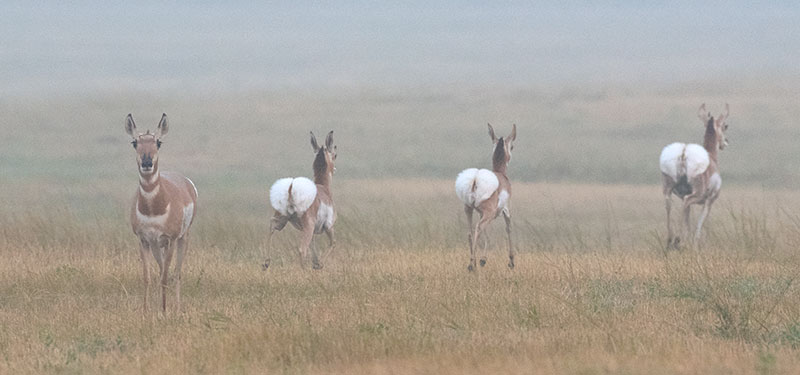Pronghorn Ups and Downs
Ron Wilson

For an animal that is neither antelope nor goat, no matter what its scientific name proclaims, life in North Dakota on the eastern edge of its range has been one of ups and downs.
The pronghorn today is a landscape staple found mostly in western North Dakota’s wide open, but ranged statewide in abundance in the 1800s, according to historical records.
Following settlement, and resulting land-use changes, the pronghorn population tumbled to an estimated 225 animals in the 1920s and to about 50 by 1940.
By the late 1940s, pronghorn numbers rebounded in parts of the state and North Dakota held its first hunting season in 1951 only in certain areas. Yet, there remained large areas of historical pronghorn range that were unoccupied.
From the early to mid-1950s, the Game and Fish Department trapped animals from elsewhere, including Montana, and released them in areas of the state they had failed to inhabit themselves. By the 1960s, pronghorn were well distributed through all western counties, and the population estimate in 1964 was about 14,000 animals.
According to Bruce Stillings, North Dakota Game and Fish Department big game management supervisor, Dickinson, the statewide population estimate for pronghorn today is about 10,100 animals.
Yet, in the roller coaster ways this population has exhibited over time, the pronghorn population is headed in the right direction, given some cooperation by Mother Nature down the road.
“The good news is that we seem to have broken out of the drought cycle, and the habitat conditions on the landscape are in much better shape today than they’ve been in a number of years,” Stillings said.
According to Department aerial survey work in July, Stillings said the pronghorn population is up 5% compared to 2021, which is a good sign, yet there are some management regions where the population is down considerably.
The biggest decrease is in hunting unit 4A in extreme southwestern North Dakota where record-low fawn production was noted.

“The data we collected in July is reflective of what these animals have experienced in the last 18 to 24 months with extreme drought conditions, poor rangeland conditions, adult females in poor body condition and lower reproductive potential,” he said. “And then heading into April, we had those two historic blizzards when the does would have been in their third trimester of their pregnancies, which could have really had a toll on their reproductive performance. Factoring in the drought and the blizzards, it’s no big surprise that fawning was way down.”
Stillings added that an epizootic hemorrhagic disease outbreak in 2021, which garnered the most news along the Missouri River in central North Dakota where EHD killed an untold number of whitetails, also had an influence on pronghorn fawn production.
“We did document losses from EHD in pronghorn this past summer and fall, and it has been shown that animals exposed to EHD the previous fall experienced much lower fawn production the following summer,” he said. “So, there’s no doubt EHD added a component to the reduction in fawn production this year as well.”
In early August the Game and Fish Department held the 2022 pronghorn lottery and all 1,965 licenses, up 245 from 2021, were issued. In total, 16,499 applications were received, including 818 gratis applications.
Also of note, and certainly good news, 17 units are open to hunting this fall, including units 9A and 9C, for the first time since 2009.
It really wasn’t that long ago that the Game and Fish Department, following a handful of difficult winters starting in 2008 that did the unthinkable and slashed the population by 75%, closed the pronghorn hunting season from 2010-13, the first such move at the time in nearly three decades.
“Northern Great Plains pronghorn are susceptible to dramatic population declines due to extreme winter conditions,” Stillings said in 2010. “The last two years have been a worst-case scenario for pronghorn in North Dakota, similar to 1977-79 when three consecutive winters hit the region, resulting in closed seasons from 1978-81.”
But that’s in the rearview and Stillings is looking ahead.
“We’re set up in really good shape. The pastures look great. Crop fields, rangeland, the conditions couldn’t be any better,” he said. “Barring one of those extreme North Dakota winters, we should, heading into next spring, have more residual cover from all the growth this summer. And then with adequate spring growth, the stage would be set for a much better fawning season next year.”
